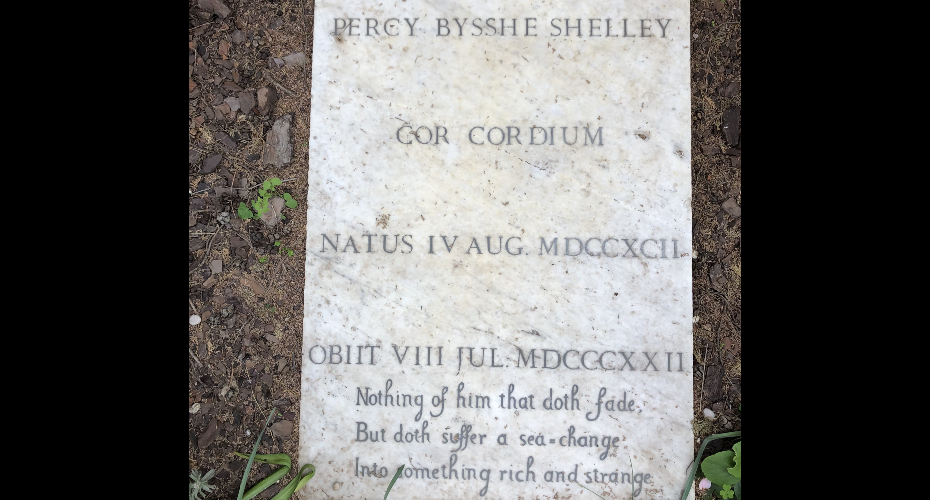New research project will explore the influence Shakespeare had upon how we remember the dead

Percy Bysshe Shelley's gravestone in the Cimitero Acattolico in Rome, taken by Tarah Wheeler in Rome in April 2019. The epitaph features a passage from The Tempest.
The influence and inspiration that William Shakespeare has had upon the practice of writing epitaphs is to be the focus of a new research project.
English Literature experts at the University of Exeter will study epitaphs and obituaries dating back to the 18th century to explore how Shakespeare’s words have shaped these elements of funerary practice.
It will employ advanced word recognition and pattern-matching software to look for direct quotations and inspirations from Shakespeare’s plays, in online databases and other sources such as newspaper archives.
The project – Shakespearean Graves: Literature and the Anglophone Way of Death – will also incorporate a special case study of more than 400,000 graves of those who fell in the two World Wars fighting for countries in the Commonwealth.
“Since around the middle of the eighteenth century, when quotations from plays including Hamlet and Cymbeline began to appear on English headstones, Shakespeare has become ever more embedded in the rituals surrounding death and commemoration in Britain, North America, and beyond,” said Philip Schwyzer, Professor of Renaissance Literature in Exeter’s Department of English & Creative Writing.
“Shakespeare appears to have been among the first secular authors in English whose works were appropriated for use in funerary contexts. Through this project, we will explore some of the circumstances around why mourners began to choose quotations from this worldly poet instead of passages of scripture.”
The three-year study, worth more than £450,000, has been funded by a prestigious Leverhulme Trust Research Project Grant and will be led by Professor Schwyzer and Dr Elizabeth Williamson from the University’s Digital Humanities Lab, and will sponsor a PhD student and two post-doctoral researchers.
The team will consult online repositories of monument inscriptions, and online and printed compilations of epitaphs for churches and cemeteries in the UK and North America. Collections of funeral sermons, eulogies, and funeral readings referencing Shakespeare will also be studied, along with printed obituaries stored in newspaper archives.
There will be a particular focus on the complete dataset of the Commonwealth War Graves Commission, which contains more than 400,000 personal inscriptions from soldiers buried in over 150 countries. This, Professor Schwyzer says, will extend the study into new communities not typically associated with research on the reception of Shakespeare. Finally, members of the team will visit and survey several cemeteries known to contain a high proportion of Shakespearean references.
By using bespoke software similar to that which recognises plagiarism, the researchers believe they will even find evidence of where Shakespeare’s language has been rewritten or reworked into new forms.
“While Shakespeare personally authored a handful of epitaphs, it would be a century later before lines from his plays and poems started to be used more widely,” adds Professor Schwyzer. “Before the end of the 18th century, his quotations were appearing on American headstones, and by the early 19th century, we find his words in countries such as Italy, where he adorns the graves of Shelley and Keats. There is even a Shakespeare epitaph on the moon!
“Launching on the 409th anniversary of Shakespeare’s death, we hope this project will enable us to learn something about why his words have come to be so meaningful to people, and about the full range of cultural and personal values are that can be expressed through the citing of his work.”




